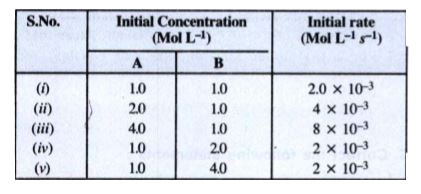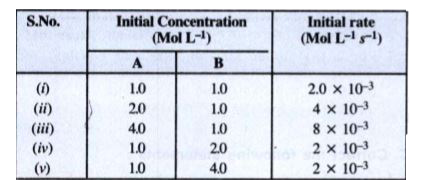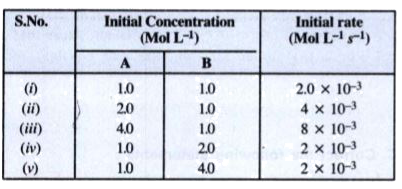Consider the reaction, A+B→C+D.
The initial rate for different initial concentrations of the reactants are given below :

Write the rate law equation.
For the given reaction, rate =k[A]x[B]y . After substituting the values of initial rates and initial concentrations, the value of x and y can be calculated. Then (x + y) will give the order of the reaction. For experiment (i) 2.0×10−3=[1.0]x[1.0]y
For experiment (ii) 4.0×10−3=[2.0]x[1.0]y ...(2)
For experiment (iii) 8.0×10−3=[4.0]x[1.0]y
For experiment (iv) 2.0×10−3=[1.0]x[2.0]y
For experiment (v) 2.0×10−3=[1.0]x[4.0]y
Determination of x. In order to get the value of x, divide equation (2) by (1)
4.0×10−32.0×10−3=[2.0]x[1.0]y[1.0]x[1.0]y,(2)1=(2)xorx=1
Determination of y. In order to get the value of y, divide equation (4) by (1)
2.0×10−32.0×10−3=[1.0]x[2.0]y[1.0]x[1.0]y,(1)1=[2.0]yory=0
Rate law=k[A]1[B]0=k[A]
Topper's Solved these Questions
- BOOK - ICSECHAPTER - CHEMICAL KINETICSEXERCISE - ISC EXAMINATION QUESTIONS (PART-II (DESCRIPTIVE QUESTIONS ) )51videos
CHEMICAL KINETICS
- BOOK - ICSECHAPTER - BIOMOLECULESEXERCISE - ISC EXAMINATION QUSTIONS (PART-I)(DESCRIPTIVE QUESTIONS)21videos
BIOMOLECULES
- BOOK - ICSECHAPTER - CHEMISTRY IN EVERYDAY LIFEEXERCISE - EXERCISE (PART - II (DESCRIPTIVE QUESTIONS) (LONG ANSWER QUESTIONS))19videos
CHEMISTRY IN EVERYDAY LIFE
Similar Questions
Consider the reaction, A+B→C+D.
The initial rate for different initial concentrations of the reactants are given below :

Calculate the rate constant.View SolutionConsider the reaction, A+B→C+D.
The initial rate for different initial concentrations of the reactants are given below :

Calculate the rate constant.View SolutionConsider the reaction, A+B→C+D.
The initial rate for different initial concentrations of the reactants are given below :

Calculate the rate constant.View SolutionConsider the reaction, A+B→C+D.
The initial rate for different initial concentrations of the reactants are given below :

What is the overall order ?View SolutionConsider the reaction, A+B→C+D.
The initial rate for different initial concentrations of the reactants are given below :

What is the overall order ?View SolutionConsider the reaction, A+B→C+D.
The initial rate for different initial concentrations of the reactants are given below :

What is the overall order ?View SolutionConsider the reaction, A+B→C+D.
The initial rate for different initial concentrations of the reactants are given below :

What are the orders with respect to A and B ?View SolutionConsider the reaction, A+B→C+D.
The initial rate for different initial concentrations of the reactants are given below :

What are the orders with respect to A and B ?View SolutionConsider the reaction, A+B→C+D.
The initial rate for different initial concentrations of the reactants are given below :

Calculate the rate constant.View SolutionConsider the reaction, A+B→C+D.
The initial rate for different initial concentrations of the reactants are given below :

Suggest a possible mechanism.View Solution
